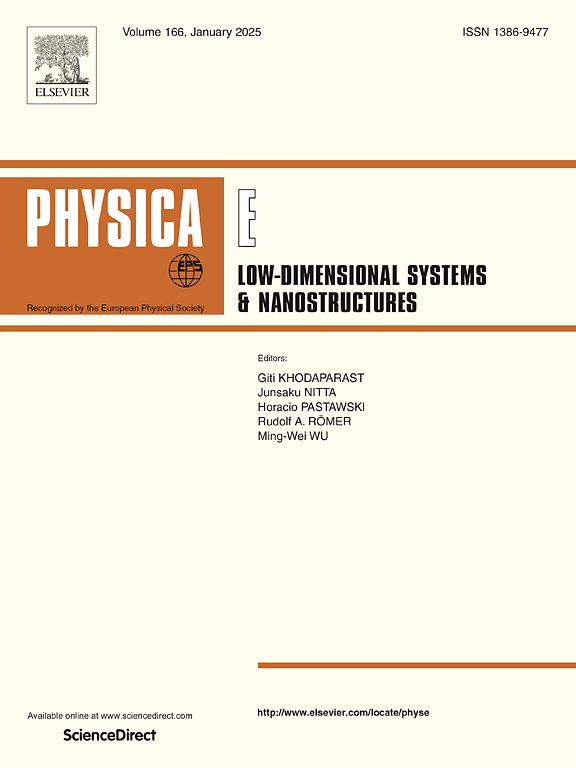Tailoring and enhancing thermal conductivity in germanene nanotubes: A superior alternative to carbon nanotubes using external fields
IF 2.9
3区 物理与天体物理
Q3 NANOSCIENCE & NANOTECHNOLOGY
Physica E-low-dimensional Systems & Nanostructures
Pub Date : 2025-04-22
DOI:10.1016/j.physe.2025.116278
引用次数: 0
Abstract
This work examines the thermoelectric behavior of Germanene nanotubes (GeNTs) relative to Carbon nanotubes (CNTs), focusing on the influence of external factors, such as chemical potential and applied fields, on their thermal and electronic behavior. Through the application of the tight-binding model and Kubo formula, thermal conductivity, magnetic susceptibility and thermoelectric figure of merit are systematically analyzed. Findings reveal that GeNTs exhibit notable advantages in both thermal conductivity and magnetic susceptibility, particularly under the influence of external fields. Furthermore, the response of GeNTs to electric and magnetic fields is closely related to variations in nanotube radius and chemical potential which enhances their thermoelectric performance over a wider temperature range. These findings highlight the promise of GeNTs as favorable materials for thermoelectric applications in environments that require significant thermal and electrical performance.
锗烯纳米管的调整和增强热导率:使用外场的碳纳米管的优越替代品
本研究考察了锗烯纳米管(agents)相对于碳纳米管(CNTs)的热电行为,重点研究了化学势和应用领域等外部因素对其热电行为的影响。通过应用紧密结合模型和Kubo公式,系统地分析了导热系数、磁化率和热电优值。研究结果表明,在外场的影响下,有机硅在导热性和磁化率方面都表现出显著的优势。此外,纳米管半径和化学势的变化与纳米管对电场和磁场的响应密切相关,从而提高了纳米管在更宽温度范围内的热电性能。这些发现突出了在需要显著热电性能的环境中,作为热电应用的有利材料的前景。
本文章由计算机程序翻译,如有差异,请以英文原文为准。
求助全文
约1分钟内获得全文
求助全文
来源期刊
CiteScore
7.30
自引率
6.10%
发文量
356
审稿时长
65 days
期刊介绍:
Physica E: Low-dimensional systems and nanostructures contains papers and invited review articles on the fundamental and applied aspects of physics in low-dimensional electron systems, in semiconductor heterostructures, oxide interfaces, quantum wells and superlattices, quantum wires and dots, novel quantum states of matter such as topological insulators, and Weyl semimetals.
Both theoretical and experimental contributions are invited. Topics suitable for publication in this journal include spin related phenomena, optical and transport properties, many-body effects, integer and fractional quantum Hall effects, quantum spin Hall effect, single electron effects and devices, Majorana fermions, and other novel phenomena.
Keywords:
• topological insulators/superconductors, majorana fermions, Wyel semimetals;
• quantum and neuromorphic computing/quantum information physics and devices based on low dimensional systems;
• layered superconductivity, low dimensional systems with superconducting proximity effect;
• 2D materials such as transition metal dichalcogenides;
• oxide heterostructures including ZnO, SrTiO3 etc;
• carbon nanostructures (graphene, carbon nanotubes, diamond NV center, etc.)
• quantum wells and superlattices;
• quantum Hall effect, quantum spin Hall effect, quantum anomalous Hall effect;
• optical- and phonons-related phenomena;
• magnetic-semiconductor structures;
• charge/spin-, magnon-, skyrmion-, Cooper pair- and majorana fermion- transport and tunneling;
• ultra-fast nonlinear optical phenomena;
• novel devices and applications (such as high performance sensor, solar cell, etc);
• novel growth and fabrication techniques for nanostructures

 求助内容:
求助内容: 应助结果提醒方式:
应助结果提醒方式:


